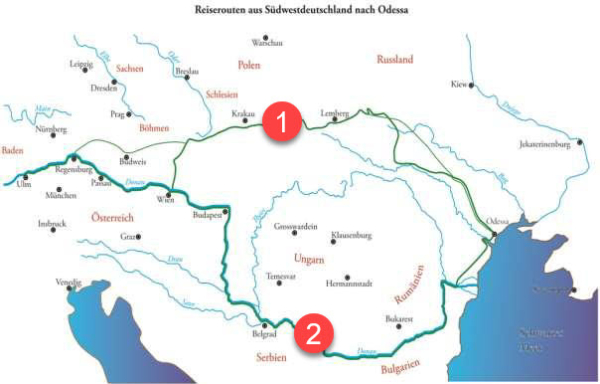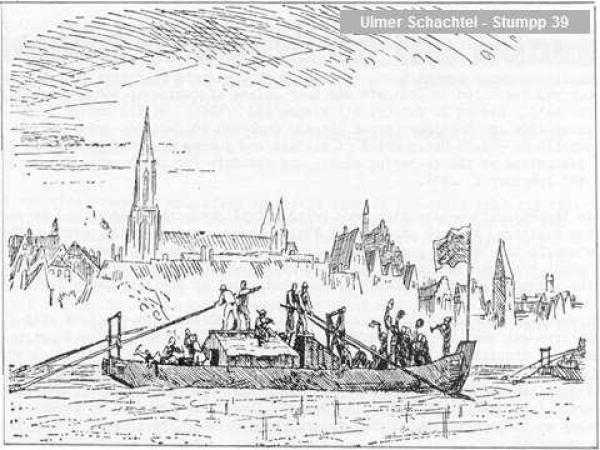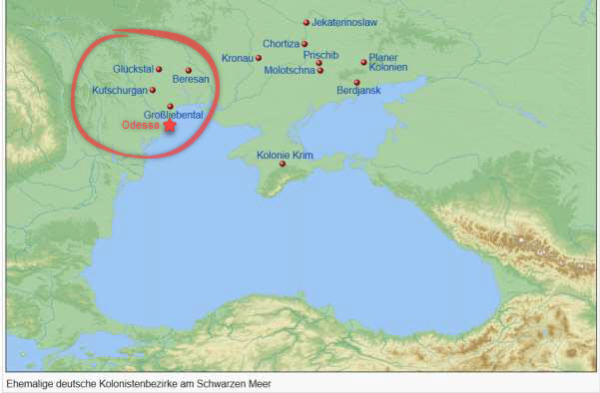_English_
User Tools
Site Tools
Sidebar
Table of Contents
5.3.5 Influx of 22 families from Odessa colonies around 1843
Already in the section “1.4 Origin of Krasna ancestors and their migration to Krasna” it was pointed out that a group of the later Krasna families moved from their original homeland Alsace and Baden to the Odessa region between 1803 and 1830. Of this group, 22 families from colonist districts near Odessa (see map below) moved to Krasna around 1843. In Odessa region there was too little land for farmers. Places became available in Krasna because at least 16 families moved abroad or to other colonies around 1843 (see previous section).
Colonists migrating to Krasna from Odessa colonies around 1843:
Source: Census für Krasna 1850; Kishinev Archive File 134-2-689
- Bachmeier, Annachn (1790), von Josephstal nach Krasna 1843
- Bauer, Mateas (1802), nach Krasna 1845
- Braun, Gebhard (1792) , von Mariental/Franzfeld nach Krasna 1843
- Drefs, Michael (1800) , von Kleinliebenthal nach Krasna 1843
- Götz, Christian (1798) , von Kleinliebenthal nach Krasna 1843
- Herrschaft, Johannes (1808), von Selz/Kutschurgan nach Krasna 1849
- Ihli, Joseph (1801) , von Kleinliebenthal nach Krasna 1843
- Ihli, Sebastian (1799) , von Baden nach Krasna 1843
- Keller, Georg (1809) , von Speier nach Krasna 1843
- Keller, Jacob (1819) , von Speier nach Krasna 1843
- Koch, Jakob (1808) , von Josefstal nach Krasna 1843
- Kreis, Florian (1806) , von Alexanderhilf nach Krasna 1816
- Kunz, Georg (1797) , von Sulz nach Krasna 1843
- Matery, Kaspar (1802) , von Franzfeld nach Krasna 1843
- Nagel, Elias Peter (1802) , von Baden nach Krasna 1843
- Nold, Joseph (1808), von Franzfeld nach Krasna 1843
- Schreiber, Jakob (1805) , von Landau nach Krasna 1843
- Spitznagel, Heinrich (1801) , von Glückstal nach Krasna 1845
- Steiert, Johannes (1791) , von Franzfeld nach Krasna 1843
- Steiert, Andreas (1794) von Kleinliebenthal 1843
- Volk, Klemens (1802), von Baden nach Krasna 1843
- Wolf, Leonhard (1791) , von Josefstal nach Krasna 1843
How and when did the settlers come to Odessa
Krasna ancestral families from Alsace and Baden emigrated to southern Russia at the beginning of the 19th century, namely members of, among others, the following families.
- Bachmeier, Däschle, Ibach, Ihli, Kunz, Nagel, Nold, Steiert, Spitznagel, Volk, Wolf from Baden,
- Herrschaft, Keller, Matery, Schreiber, Zerr, from Alsace.
They belonged to the so-called “Black Sea Germans”. These were German emigrants who settled on the northern shore of the Black Sea between the rivers Bug and Dniester, near the port city of Odessa. Their settlement area is today on the territory of Ukraine.
Russia's Tsar Alexander I was looking for people for his newly conquered territories on the Black Sea and advertised for them especially in Germany. In a decree of 20. 2. 1804, he demanded that emigrants fulfill certain conditions:
- Minimum wealth 300 gulden,
- a good character certificate from the home authorities,
- model farmers with good agricultural knowledge, including viticulture,
- well-educated craftsmen.
The wave of emigration to the Black Sea region began in 1803. Those wishing to emigrate from Alsace, the Palatinate and Baden were able to register at specially established collection points in Frankfurt, Rothenburg, Regensburg, Ulm and Lauingen on the Danube. Those wishing to enter the country had to present “passports, certificates or other documents issued by magistrates or municipalities attesting to the good conduct of the person presenting himself”.
Advertising for New Russia was halted by the Russian Foreign Minister's decree of February 1820. Smaller immigrant groups, however, continued to enter the country with special permits. Among them was the family of Elias Nagel, who emigrated only in 1829/1830.
The travel route
The travel routes of emigrants were long, uncertain and arduous. The emigrants from the Lower Alsace crossed the Rhine and gathered in Plittersdorf near Rastatt. They were joined by emigrants from the Palatinate and Baden. The columns moved overland to Ulm.
From Ulm and Lauingen, they were transported by the “Russian Imperial Colony Transport Station” on ships (Ulmer Schachteln) on the Danube to Regensburg or Vienna. From here there were two routes
- one overland through the Carpathians and Galicia to Russia (Dubosary),
- another on the Danube (from Galatz or Ismail overland to Dubosary and on to Odessa).

Source:https://www.auswanderung-rlp.de/ziele-der-auswanderung/auswanderung-nach-osteuropa/einleitung.html
The overland route
The group that chose the overland route had to move from Regensburg or Vienna via Bohemia, Moravia, Silesia, Galicia to the Russian border town of Radziwillow and on to Dubossary and Odessa. Another variant of the overland route went from Frankfurt/a.M. via Leipzig, Dresden, Breslau, Lemberg /Lvov), Radziwillow. Because of bad roads, the overland journey took almost three months at that time. In Radziwillow many young people got married in order to acquire the right to a whole farm as a family. They spent the winter in Radziwillow and then continued their journey through Podolia to the mouth of the Dniester River.
The way across the Danube
The emigration began on lightly built, wooden barges, the so-called Ulmer Schachteln. In Vienna, the emigrants were distributed to other Danube barges. Despite epidemics, heat, cold and shipwrecks, between 1803 and 1830 numerous settlers made their way on the Danube via Vienna - Budapest and Belgrade to the former Turkish fortress of Ismail in the Danube delta. From there they continued overland to Dubossary or Odessa. Here the assignment to the individual colonies in the Black Sea area took place. The first German emigrants from the southwest (Württemberg, Baden, Alsace, Lorraine, Palatinate) arrived in the fall of 1803. There are travelogues about the hardships and dangers the future colonists faced, available as descriptions or as letters.

Source:http://www.russlanddeutschegeschichte.de/geschichte/teil1/ankunft/wege3.htm
The “Ulmer Schachtel” was a long barge with a house-like superstructure. The total length was 30 m, the height of the side, measured in the middle of the barge, was 150 to 160 centimeters, the largest width was 7.5 m, the length of the house-like superstructure was 5 to 6 m. The total height of the barge was about 4 m. The vessel had 2 rudder blades at the bow and in the middle of the ship, and 2 to 4 at the stern. These rudder blades were also used for steering.
Transport lists are only partially available and only about the first transports in 1803/1804, not about the voyages of the second big wave of immigration in 1808-1810. Later Krasnaers are not to be found in the existing lists. They came either with the unlisted transports or on their own.
To demonstrate the hardships the emigrants took upon themselves, the course of the first transport is described here: The French officer Franz Ziegler recruited a total of 1141 people in 1803 and sent them in ten transports from Ulm to Odessa. The first transport left on 20.06./02.07., the others followed at intervals of 10 - 15 days each. The crossing from Ulm to Galatz on the Danube and from there by land to Dubosary took between 82 and 88 days.
Half of the members of the 1st transport arrived already sick in Galatz, where there was no doctor. From Galatz to the Russian border town of Dubosary, the transport took ten days. Several people died on this route. Many of the arrivals who reached Dubosary on August 24, 1803 were sick. 91 persons of the first transport could leave the quarantine on September 4. 61 of them were forwarded to Odessa, the remaining 30 stayed in Dubossary for the time being.
Franz Däschle, the father-in-law of Johann Steiert, who moved to Krasna in 1843, traveled with the first transport.
The colony foundations in the Odessa region
The first German emigrants from the southwest (Württemberg, Baden, Alsace, Lorraine, Palatinate) arrived in Odessa in the autumn of 1803.
The Russian government provided land for the establishment of settlements for the arriving emigrants. This did not form a contiguous area, but was allocated in several places, in accordance with the goal of settling model farmers. The villages founded on it were grouped into the following four colonist districts (Later Krasna settlers initially lived in all four districts; their domiciles are marked in red below).

Source:https://de.wikipedia.org/wiki/Schwarzmeerdeutsche#/media/File:BlackSea.svg
The closed settlement areas in the Black Sea area.
- The Grossliebental area is located in the immediate vicinity of the city of Odessa. October 17, 1803 is considered the day of its foundation. Tsar Alexander I bought land for the colonists on that day. The oldest settlement was Grossliebental. In the years 1804 to 1806 other colonies were established, in total there were ten; six were Protestant (Großliebental, Alexanderhilf, Neuburg, Peterstal, Freudental, Lustdorf) and 4 were Catholic: Mariental,
Kleinliebental = Drefs, Götz, Joseph Ihli, Andreas Steiert
Josefstal = Bachmeier, Koch, Wolf
Franzfeld = Braun, Matery, Nold, Johann Steiert
The Protestant settlers came mostly from Württemberg, Baden, and the Palatinate; the Catholics from Alsace and the Palatinate. - The Kutschurgan area - so named after the small river of the same name, on which 4 of the 6 villages were located. Most of the immigrants came from Alsace, Baden and Palatinate. They arrived in 1808 in the second wave of immigration. The six colonies of the district were Catholic:
Baden = Sebastian Ihli, Volk, Nagel
Selz = Herrschaft.
Kandel, Mannheim, Alsace, Strasbourg.
At the level of the former colony of Baden today lies the border between Ukraine and Moldova. - The Beresan area - named after the little river Beresan (founded in 1809/1810). These are 4 Protestant (Johannestal, Rohrbach, Waterloo, Worms) and 7 Catholic parishes of Karlsruhe, Katharinenstadt, Munich, Rastadt,
Landau = Schreiber
Speier = Keller,
Sulz = Kunz.
The inhabitants of the Beresan area were mostly from Baden, Alsace, Württemberg and the Palatinate. - The Glückstal area, (founded in 1808) consisting of 4 Protestant parishes
Glückstal = Spitznagel,
Bergdorf, Neudorf, Kassel. The countries of origin are mainly Württemberg, Alsace and Baden.

